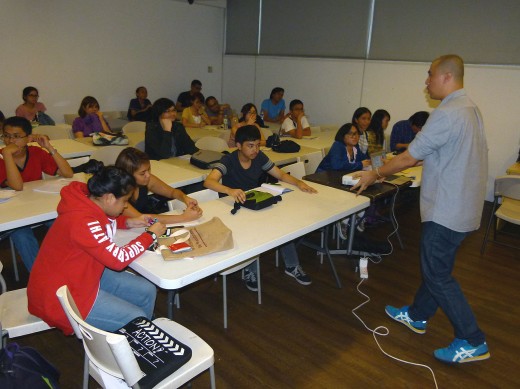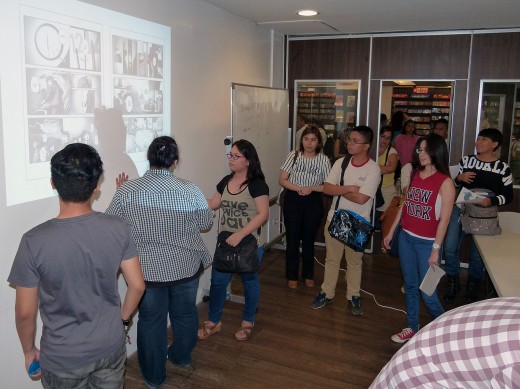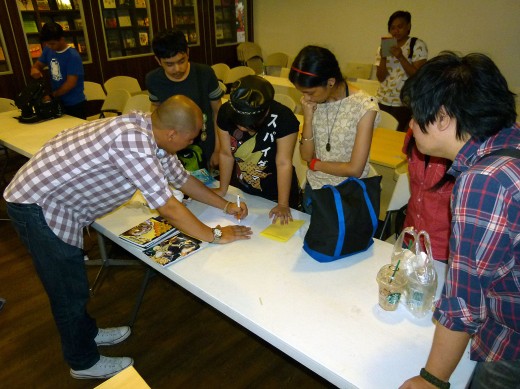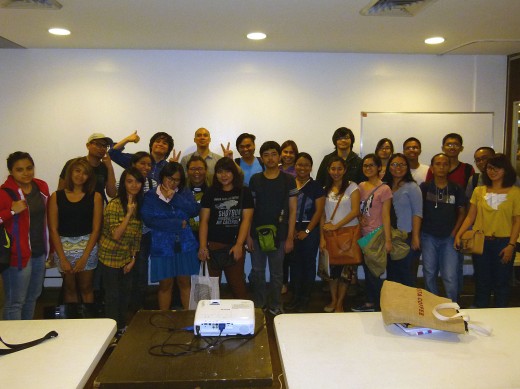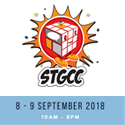LET’S TALK KOMIKS: Komiket University Batch 2015
On this Let’s Talk Komiks, we feature some students of Batch 2015 of Komiket University: Jillian Combe, Jess Santiago, Maria Criselda Santos, Jez Nabong, Eden Sarmiento and Guia Baylon with Paolo Herras. We get to learn on what they’ve learned and experienced in the workshop. As well as, how they’ve evolved as comic book creators/writers/artist.
This is Let’s Talk Komiks.
FLIPGEEKS: Hello y’all. I would like to know on how did you guys start this workshop?PAOLO HERRAS: One of the goals of the Komiket is to grow the comics community. To achieve that, we’d have to discover and nurture new creators. Since part of the Meganon Comics advocacy is teaching, Tepai (Pascual) and I decided to put the 1st Comic Book Creator’s Workshop under the Komiket. We did several call-outs, and 36 artists and writers became the first batch of the workshop. Their goal was to finish a comic book (one-shot or one chapter) which they will release in the Komiket. They are given a table where they can sell their work and learn how to be creative entrepreneurs.
About the workshop, what list of activities do you all do?
JILLIAN COMBE: Specifically the workshop is on 4 days in total with the activities in order Concept, Character and Comic Book Cover, Story Journey and Visual Storytelling, Comic Book Production, and Workshop Proper – Creator’s Survival Guide to comic events, Publishing and Distribution.
Has this workshop given you all confidence and more focus to make a comic?
JILLIAN COMBE: Also for me being one of his students, this workshop has enlightened me the least on how to make comic books in a very accurate way, and the tips on surviving a comic book event.
It does give me a lot of confidence in a way for me as a writer of one collaboration and an artist in another currently that I could highlight and present my skill to the public and show them what I can do.
Could you please give some, a tip or two on how to survive a comic book event? By the way, are you an artist, writer or cartoonist?
JILLIAN COMBE: One of the tips on surviving the comic event is also the presentation of the table in the event. Comic Book Covers are one of them. I am more of an Artist and a writer.
Comic book covers? How so?
JILLIAN COMBE: In the presentation of the table, comic book covers, for me as a reader, could pull me into interest into reading the comic. Especially on how the composition of the art is and the symbolism that can be implied which gives an idea of the story that they might be expecting more or less.
Are colored and B&W covers a factor? How about art style? Is there a trend of art style that people prefer nowadays? What have you noticed?
JILLIAN COMBE: I could say yes with that statement. Art style is not much of an issue, but to the consideration that people have different taste with it. Mostly the art styles today as I noticed should blend well with the story. Like the whole idea of the story the vibe of the setting, etc. and how heavy the story could be as the readers could go through, reading page by page.
How many cons have you attended before deciding that you wanna do komiks?
JILIAN COMBE: I could say around 3-4 cons before even doing so. I mean there is motivation for making komiks ever since. But of course it gives me some thought if the stories made should be publicized or not
Has your view changed from being as a con-goer to as a comic book creator?
JILLIAN COMBE: It kind of does and it is a huge change. Because for me as a con-goer before, I see a lot of works on tables that could be interesting even for those being first time sellers at a con selling merch to promote their comics or maybe a game of some sort. At first I thought it was that easy to promote yourself with you just having your own work that you could be proud of. But for attending this workshop it made me realize that I should make a story that everyone could go for, and not only for yourself. It was hard to even get your work to be noticed, or even your idea to be in anyone’s favor. Even on the cost of production just to present to the audience is one thing. As it is just throwing your personal expenses there.
Has Paolo instructed you all should to have a lot of barya for purchase change?
PAOLO HERRAS: Hahahahaha! That’s the one thing I forgot! Mag-ipon ng barya. Like 1,000-2,000 worth of 5s, 10s, 20s, 50s. and 100s. Tepai and I bring 4,000 worth of loose change (but that’s not to be announced). Hahahaha! We save all our 20s and 5s in bottles. And yes, nauubos siya.
Who are the lecturers sa batch nyo? What have you learned from each of them? Any funny moments?
JILLIAN COMBE: Sir Paolo for the writers side and Miss Tepai for the artist side of things.
I learned from them on having a good flow with your collaborator. On how to manage the workflow and so on.
Funny moments… mukhang madami kasi nangyari, eh. Hahaha.
PAOLO HERRAS: The other Komiket Committee JP, Jonzam and Mark Navarro also helped. We had one extra workshop day where they discussed their group’s storylines for improvements. We couldn’t have done that without them.
And they were present every day of the workshop in case we needed help.
JILLIAN COMBE: I recall on how sir Paolo would try to illustrate things during the lecture when Miss Tepai is there and in able to illustrate if needed. Hahaha
Sir Paolo, sinasabi ko lang po yung isa, hindi ko na po itutuloy. Hahaha
PAOLO HERRAS: Hahahaha! The challenge was how to hold a workshop even if the stories were romance, humor, superhero, supernatural, crime, or wordless. Tepai and I are very proud of all our students. See, this is why I shouldn’t answer, kasi ang showbiz ng mga sagot ko. Hahaha!
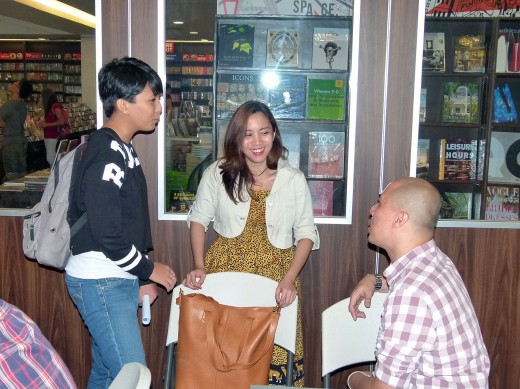
May favoritism ba, Paolo?
JILLIAN COMBE: Meron nga ba sir? Hahaha
PAOLO HERRAS: Hey! Wala akong favorites! All creators are created equal in the workshop. No special treatment. We had a super senior writer from television & film, we had a very young workshopper, nephew of the great Carlo Vergara, but nobody knew that.
We treated each creator and each creation equally to the best of our ability.
Pero so far, sinong student ay medyo promising to be a great creator in the lokal komiks scene?
PAOLO HERRAS: Just the mention of the the senior writer and nephew of Carlo. Hahahaha. But there’s nothing naman that’s super top secret. I would just prefer it would be less about me and Tepai, and more about the new creators and their work.
Hahaha! You guys be the judge! Every one is full of potential. It’s what they make of their talent and skills that’s what will count in the long run.
How did you find out about this workshop?
GUIA BAYLON: I found about it through FB. I’m a big komiks fangirl and I’ve been following komiks pages and komiks creators since 2012.
If my memory serves me right, sa Komiket page ko sya originally nakita. Di na ako nagdalawang isip pa kahit ipit sa budget ko. I knew it was a rare opportunity to join a class like this.
And after that, kinalat ko na sa mga friends ko na gusto rin mag komiks.
MARIA CRISELDA SANTOS: I learned about the workshop on Facebook, when I saw the poster shared by Komiket. I got curious and signed up right away.
EDEN SARMIENTO: I found it through FB, as well. I’ve been following Komiket for quite some time. I have made comics before and I think it’s a great opportunity to learn from people who’ve been in the comic scene longer than I have.
JESS SANTIAGO: MariaCriselda “Dhang” Santos shared the Komiket poster on FB. I was looking for something to learn, so I decided to give the workshop a shot. I had never heard of Komiket at that time, but I had some awareness of the komiks scene after joining BLTX with the writing group Charging Station in January. This is my first time to make/co-create a comic book. (Note: Dhang also joined Charging Station after BLTX.)
JEZ NABONG: My editor for the school newspaper made a post about it on our Facebook group and I was curious. I’ve always had an interest in making comics, and I thought that joining something like that would be fun.
Ano ang mga views ng family nyo about you involving through art, komiks and this workshop?
JEZ NABONG: Parents? They’re both very supportive and kind. My dad is also interested in comics too. But I haven’t told them that we were making a full-fledged comic, so I’d be able to surprise them.
JILLIAN COMBE: They think that it would be a good time for me to at least get my skills out there and maybe learn more as I go along, even meeting new people in addition, in terms if it’s collaboration or being just a solo writer-artist.
MARIA CRISELDA SANTOS: My father is supportive with everything I do. He doesn’t read comics but I’d probably coerce him to buy a copy.
EDEN SARMIENTO: They’re very supportive about the workshop. I’m a Fine Arts graduate, so I think it’s a great opportunity for me to learn more.
GUIA BAYLON: I’ve always dreamed of becoming a comics creator, something I realized when I was about to enter college. Though my family were mostly komiks readers, they were against taking an Arts or Writing course because of the “no money there” argument.
I didn’t tell them about the workshop in fear of the same argument. But I know if my mom were still around, she’ll support me here as well.
JESS SANTIAGO: I’m not sure what my parents think about my making komiks or joining this workshop, but I guess they’re supportive. I think they are. I hope they are. Haha!
But, with that. Ano ang books/comics binabasa nyo? Comic-con goers kayo?
GUIA BAYLON: I’ve been a regular Komikon goer since 2012… but before that, my first komiks would be Funny Komiks. Then there was Pugad Baboy. Later on, I discovered Kikomachine. My komiks collection just exploded after I started going to komikon.
JEZ NABONG: I mostly read webcomics. Either user-generated ones on Tapastic.com or published ones on Webtoons.com. And I’ve also been working on my own webcomic too. But I’m also interested in reading manga and manhwa. Not so much on traditional-type comics like superhero comics, but I think they’re also interesting.
JESS SANTIAGO: I read Ben, Zits, Kiko Machine, News Hardcore — the stuff on newspapers was my first exposure to comics. The first graphic novel I ever read, though, was in 2012: Blankets by Craig Thompson. I didn’t read much comics before that, because I didn’t know how to read them: “Do I start from issue 1, can I skip to issue 100+?” I also had that misconception that comics were for superhero stories (period), which I wasn’t into. After Blankets, I read Habibi, and after that Box Office Poison — coming of age, life and love stuff. I’m still learning. And, yeah, I only really learned about komiks (with a K) in January when I joined BLTX.
MARIA CRISELDA SANTOS: I read Trese and Kikomachine, mostly. When I met Paolo at the Phil International Festival – Book Industry Summit (PILFBIS) last year, I was introduced to yet another publisher of cool and wonderfully-done comic books.
EDEN SARMIENTO: I self-publish comics since 2011. But, I read different types of comics. I don’t stay in just one genre.
What have you learned sa workshop? Any fave instructors and why?
JEZ NABONG: Nope! They’re both awesome! I learned a lot from both of them, and I feel like I could relate to them in a way because I also have a background in Advertising, but love to do comics.
JILLIAN COMBE: Wala ako sa favoritism I idolized both sir Paolo and ms Tepai for their works so much in komiks.
GUIA BAYLON: I learned a lot. It sounds corny but it really made me appreciate komiks much better. The facilitators did their best to cover all points based on their own personal strengths and experiences. Sir Paolo focused more on the planning and writing. Miss Tepai is more on the art and visual storytelling.
For each workshop session they would discuss alternatively depending on the topic on planning, sir Paolo explained about the storyline, doing the outline, making the script, collaborations, etc.
JEZ NABONG: If you wanna make comics, you have to know that it requires a lot of DISCIPLINE. That’s the biggest realization. Because of this workshop, I’ve trained myself to finish a certain number of pages in a day. I’ve never been very disciplined with making comics before, and I just do them whenever I want to. But if you really want to get stuff done, you have to know how to discipline yourself. I also learned that collaboration makes content so much better because it’s like me and my writer Jess check and balance each other out. I tell her stuff she could improve on in the story, and she can tell me stuff to improve in the art. It’s a nice thing to have because there are things that she notices that I’d probably miss.
MARIA CRISELDA SANTOS: So far I have learned to submit your scripts on time (my bad, because I worked slowly) and to always consider what your co-creator thinks. I have no fave instructor. Both Tepai and Paolo facilitated the workshop effectively.
EDEN SARMIENTO: I learned a lot from the experiences they’ve shared in self-publishing comics. I’ve experienced some of it, too. But, I’ve learned new things from their perspective.
GUIA BAYLON: On the art side, Miss Tepai showed examples on paneling, emotions, etc. it also helped us writers get a better perspective on what we can expect from our artists, especially with the time frame.
JESS SANTIAGO: How to tell a story visually (something I’ve always been wanting to learn); how to make a proper storyline; the marketing/entrepreneurial side of the creative industry; and how to collaborate with someone else (I’m either really intense or really shy around new people, so it can be challenging to talk even though I do like collaborating.) I also learned not to overthink my writing, or else the story will get lost.
I think the instructors balance each other out, so I don’t have favorites.
Eden, you’ve mentioned that you’ve published your own stuff before the workshop, what improved, in what aspects and detail?
EDEN SARMIENTO: I had to keep in mind the promotional side of making comics. Also, I learned new things about the different processes of making one, in terms of writing, drafting, etc.
Personally, going solo or going collaboration work best for you?
JILLIAN COMBE: For me, collab work is efficient due to the flow like, being a writer and my partner being the artist and so on. Rather than having the work all to yourself, well that’s my personal thought as a collaborator.
EDEN SARMIENTO: (For the previous question) I’ve done anthologies with my org-mates back in college. So, I wanted to try doing something solo for now.
This year ba ang first time nyo maglabas ng komiks?
JILLIAN COMBE: Yes for me being a college student, and it would be a good opportunity to take it
Eden, have you shared amongst your classmates about making komiks? Tinatawag nyo ba si Eden ng “ate”?
JILLIAN COMBE: Our treatment is more likely equal than getting the who’s the eldest treatment. And yes, I’ve been called out sometimes to share my experiences.
EDEN SARMIENTO: They don’t call me ate. There are people in the workshop who are more experienced and older than I am. But, we help each other out, all the same.
With the lecturers sa workshop, na celebrity shock ba kayo sa kanila?
GUIA BAYLON: Ako, medyo. Hehehe
JILLIAN COMBE: Same, medyo lang.
JEZ NABONG: I didn’t know Paolo and Tepai before the workshop, even though I remember that I’ve already met with them and talked to them before. They came to our school during University week to sell their comics.
GUIA BAYLON: I’ve seen them in komikons before, eh. Pero being there as their student has its own different hype.
JESS SANTIAGO: I came in knowing very little about komiks or Komiket, so I wasn’t celebrity shocked. It felt more like the first day of classes in college, where I barely knew anyone and I didn’t know who the professors were. Everyone has been patient and welcoming, though.
Paolo mentioned about Jon Zamar, JP Palabon and other artist personalities, ano natutununan nyo sa kanila?
EDEN SARMIENTO: We shared our ideas with them and they would give feedback.
GUIA BAYLON: Especially during that one sunday where they reviewed our storylines
To some artists and writers, comments from editors are hard to take in. How did you guys strive past that?
GUIA BAYLON: I’d like to share with you what Lourd de Veyra told me during one of his workshops, “you need to kill your baby”.
JILLIAN COMBE: That saying also implies in my classes
GUIA BAYLON: I used to take comments personally kasi. esp. with my writing. but i realized na other people see what you can’t. So i learned to listen to their comments, then think if it makes sense or not.
MARIA CRISELDA SANTOS: Comments from Paolo and the rest of the Komiket facilitators, I’m glad that they are not harsh, haha .
JEZ NABONG: All incredibly constructive. Everyone was so nice and supportive that it’s very uplifting to have such a nice workshop community. Lots of encouragement. It was also nice how some of them explained how to improve in detail, so that we knew what to do in the future.
EDEN SARMIENTO: I have to know from their perspective, as well. I could always ask why if I don’t understand. And sometimes, they don’t see mine, so I explain. From there, we work on it. Because, after all, we’re working on the same goal, which is to make the storyline/comic better.
JESS SANTIAGO: The editing atmosphere at Komiket has been one of collaboration, not dictation. So people have been tactful yet constructive with their feedback (Mr. Paolo likes to punctuate with smileys). It’s very encouraging if you’re just starting out.
Would you recommend this workshop to everyone who wants to get into comics? Why?
JESS SANTIAGO: Yes. It’s a good way to not only learn, but also to meet people with new ideas and to learn about publishing.
JILLIAN COMBE: I would recommend them so they could be aware on how comic making works, especially for those who wishes to make comics. And also make them experience this kind of opportunity as well.
GUIA BAYLON: Yes. I’d recommend it 100%. This workshop gives you a better understanding about the comics industry and how you can be a part of it. The most valuable things you can learn are from the facilitators themselves, who were willing to share their own learning and experiences when they were in our shoes.
EDEN SARMIENTO: The workshop is really worth it, especially for those who really want to try publishing their own comic books.
JEZ NABONG: OMG, YES. It’s great for expanding your horizons and getting to know people who love the same stuff you do. Communities like this help with spurring creativity and making great content. It just feels a bit awkward at first because I barely knew anyone, and would like to get to know them more during the workshop. It would have been nicer if the meetings were more frequent, or less time-constrained
JILLIAN COMBE: Even if this is the first ever workshop established. I really say it went well and seeing how we are right now, so why not recommend it to anyone if ever they open up another~
GUIA BAYLON: If I have the funds and the time, id go to the second round.
JILLAIN COMBE: Same for me
GUIA BAYLON: No regrets.
What do you think your books will happen without this workshop?
JILLAIN COMBE: I guess my writing skills won’t be that much…enhanced and my experiences will remain limited as it is, which well might result to having a sort of half-baked work.
GUIA BAYLON: i think it wouldn’t have that much direction. we won’t have the much needed feedback to help improve our work.
EDEN SARMIENTO: My book will not be published at all! The idea’s there, but I never put it into writing.
MARIA CRISELDA SANTOS: Without the workshop, I wouldn’t have known the kind of work creators put into the comic book. I initially thought it was easy, but now I greatly respect and admire the writers and the artists in the industry.
GUIA BAYLON: Ditto on what Eden said
JEZ NABONG: I probably wouldn’t have learned how discipline myself and to work very hard on something you love. I also wouldn’t have met very interesting people in the workshop, including my awesome writer Jess! She’s been very sweet and helpful with making the content as clear and “feelsy” as it can be. (I confess that my eyes started tearing up when I sketched out the last few pages of the comic. So. Much. Feels. >w<) It’s been a great journey so far, and I’m so excited to finally finish this thing. We’re getting close! smile emoticon
JESS SANTIAGO: Without the workshop, I probably would not have made a komik and would probably be drowning in my quarter-life crisis. On a personal note, my grandfather passed away a week before the workshop started, so creating and collaborating at Komiket helped me turn the sadness into something nice. I hope that shows in Things to Remember. Jez Nabong (artist of Things to Remember) has been great in keeping the uplifting tone of TTR, both in her art and in her feedback! If it weren’t for her, I would have written a rather somber story.
Eden Sarmiento has recently released – Welcome Home. It’s about a dying hamster, named Scarlet, who wants to see her owner one last time.
Guia Baylon has put out Koi no Yokan – Jaz needs to make sure that her first date with Gerald goes perfect. Because according to her dream diary, Gerald is her future husband. She tries her best to avoid the mishaps written in the diary but it still happens. Will she be able to save the date or will all her efforts be in vain?
Jess Santiago and Jez Nabong have Things to Remember – old Banchi must help his wife Hon remember their family before they all come for a special breakfast. The problem is, Hon has begun losing her memory, and Banchi is the only person she remembers. It is up to Banchi to find the one thing that will bring his wife’s memories back — and he must find it soon — or else their happy celebration will turn into a sad occasion.
Jillian Combe‘s is entitled, Tales of Kaiser (tentative title) – a young aspiring adventurer named Dice McSaint, sets out on his way to Kaiser Central University, to fulfill his dream of venturing out to the world. With the annual entrance examinations going on, will he be able to pass the trials in his favor or will it only remain a dream forever?
Maria Criselda Santos teams up Anne Garcia for Red Moon - Emil, a jobless and easy-going guy, who was given the power to see aswangs and elementals. He must then use this power and learn how to fight these creatures who wish to dominate Manila and turn the rest of the populace into their own kind.
Its good na dumadami ang female comic creators sa komiks scene
GUIA BAYLON: Hahaha, Yes, I read about that in Itutuloy na konti lang ang female komiks creators
Itutuloy?
GUIA BAYLON: Its the e-book in supplement to the comics anthology – Abangan that was released in 2014. It gave a lot of useful insights on how komiks creators now see the industry like yun nga konti lang ang female creators and yung lack of feedback for indie artists
JILLIAN COMBE: That’s actually something to agree on though.

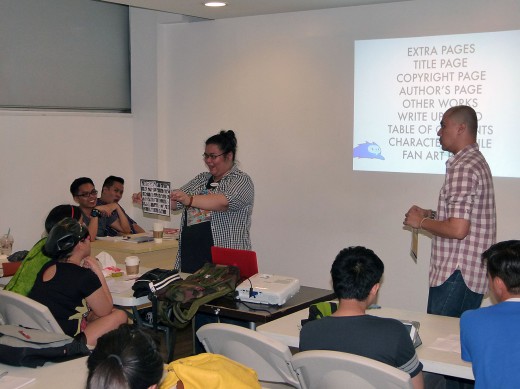
![KOMIKET UNIVERSITY Day 4 - [Activity] Observe the effectiveness of covers (art style, cover design, colors, etc.) Part 2](http://www.flipgeeks.com/wp-content/uploads/2015/09/Day-4-Activity-Observe-the-effectiveness-of-covers-art-style-cover-design-colors-etc.-Part-2-520x389.jpg)
